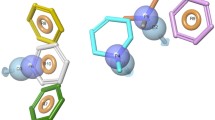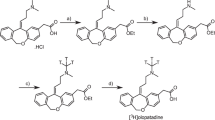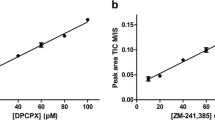Abstract
G protein coupled receptors (GPCRs) belong to the most successful targets in drug discovery. However, the development of assays with an appropriately labeled high affinity reporter compound is laborious. In the present study an MS-based binding assay is described using the rat histamine receptor 2 (rH2) as a model GPCR system. Instead of using a purified receptor it is demonstrated that it is possible to use an unpurified receptor to extract active compounds from a solution or small mixture of compounds. By using SEC it is possible to separate the bound ligand from the unbound ligand. The major advantage of this approach is that there is no labeling of ligands required (direct monitoring based on the appropriate m/z values).






Similar content being viewed by others
References
Smit MJ, Timmerman H, Verzijl D, Leurs R (2000) Pharm Acta Helv 74:299–304
Cacace A, Banks M, Spicer T, Civoli F, Watson J (2003) Drug Discov Today 8:785–792
Vassilatis DK, Hohmann JG, Zeng H, Li F, Ranchalis JE, Mortrud MT, Brown A, Rodriguez SS, Weller JR, Wright AC, Bergmann JE, Gaitanaris GA (2003) Proc Natl Acad Sci USA 100:4903–4908
Lundstrom K (2005) Trends Biotechnol 23:103–108
Civelli O (2005) TIPS 26:15–19
Lee DK, George SR, O’Dowd BF (2005) Life Sci 74:293–297
Wilson S, Bergsma DJ, Chambers JK, Muir AI, Fantom KG, Ellis C, Murdock PR, Herrity NC, Stadel JM (1998) Br J Pharmacol 125:1387–1392
De Boer AR, Letzel T, van Elswijk DA, Lingeman H, Niessen WMA, Irth H (2004) Anal Chem 76:3155–3161
Derks RJE, Hogenboom AC, van der Zwan G, Irth H (2003) Anal Chem 75:3376–3384
Hogenboom AC, de Boer AR, Derks RJE, Irth H (2001) Anal Chem 73:3816–3823
Gustavsson S, Samskog J, Markides KE, Langstrom B (2001) J Chromatogr A 937:41–47
King R, Bonfiglio R, Fernandez-Mezler C, Miller-Stein C, Olah T (2000) J Am Soc Mass Spectrom 11:942–950
Van Elswijk DA, Tjaden UR, van der Greef J, Irth H (2001) Int J Mass Spectrom 210:625–636
Annis DA, Nazef N, Chuang C-C, Scott MP, Nash HM (2004) J Am Chem Soc 126:15495–15503
Annis DA, Athanasopoulosa J, Currana PJ, Felscha JS, Kalghatgia K, Leea WH, Nasha HM, Orminatia J-PA, Rosnera KE, Shipps Jr GW, Thaddupathyb GRA, Tylera AN, Vilenchek L, Wagner CR, Wintner EA (2004) Int J Mass Spectrom 238:77–83
Malan SF, van Marle A, Menge WM, Zuliana V, Hoffman M, Timmerman H, Leurs R (2004) Bioorg Med Chem 12:6495–6503
Arrang JM, Garbarg M, Schwartz JC (1983) Nature 302:832–837
Ruat M, Traiffort E, Arrang JM, Leurs R, Schwartz JC (1991) Biochem Biophys Res Commun 179:1470–1478
Traiffort E, Ruat M, Arrang JM, Leurs R, Piomelli D, Schwartz JC (1992) Proc Natl Acad Sci USA 89:2649–2653
Leurs R, Smit MJ, Menge WM, Timmerman H (1994) Br J Pharmacol 112:847–854
Bakker RA, Schoonus S, Smit MJ, Timmerman H, Leurs R (2001) Mol Pharmacol 60:1133–1142
Hoffmann M, Verzijl D, Lundstrom K, Simmen U, Alewijnse AE, Timmerman H, Leurs R (2001) Eur J Pharmacol 427:105–114
Lundstrom K, Michel A, Blasey H, Bernard AR, Hovius R, Vogel H, Surprenant A (1997) J Recept Signal Transduct Res 17:115–126
Author information
Authors and Affiliations
Corresponding author
Rights and permissions
About this article
Cite this article
Derks, R.J.E., Letzel, T., de Jong, C.F. et al. SEC–MS as an Approach to Isolate and Directly Identifying Small Molecular GPCR–Ligands from Complex Mixtures Without Labeling. Chroma 64, 379–385 (2006). https://doi.org/10.1365/s10337-006-0058-9
Received:
Revised:
Accepted:
Published:
Issue Date:
DOI: https://doi.org/10.1365/s10337-006-0058-9




